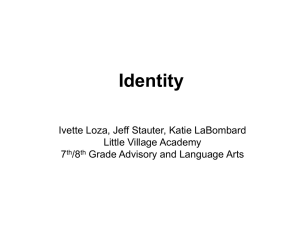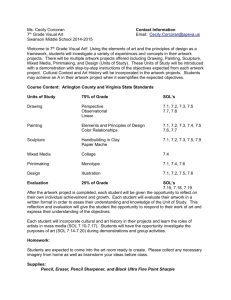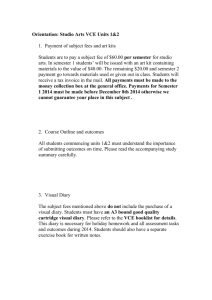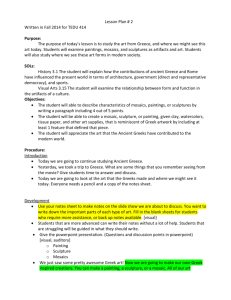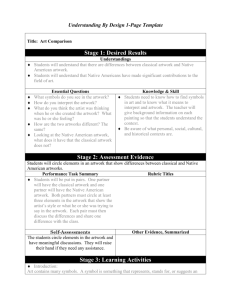File - Foothills Art Club
advertisement
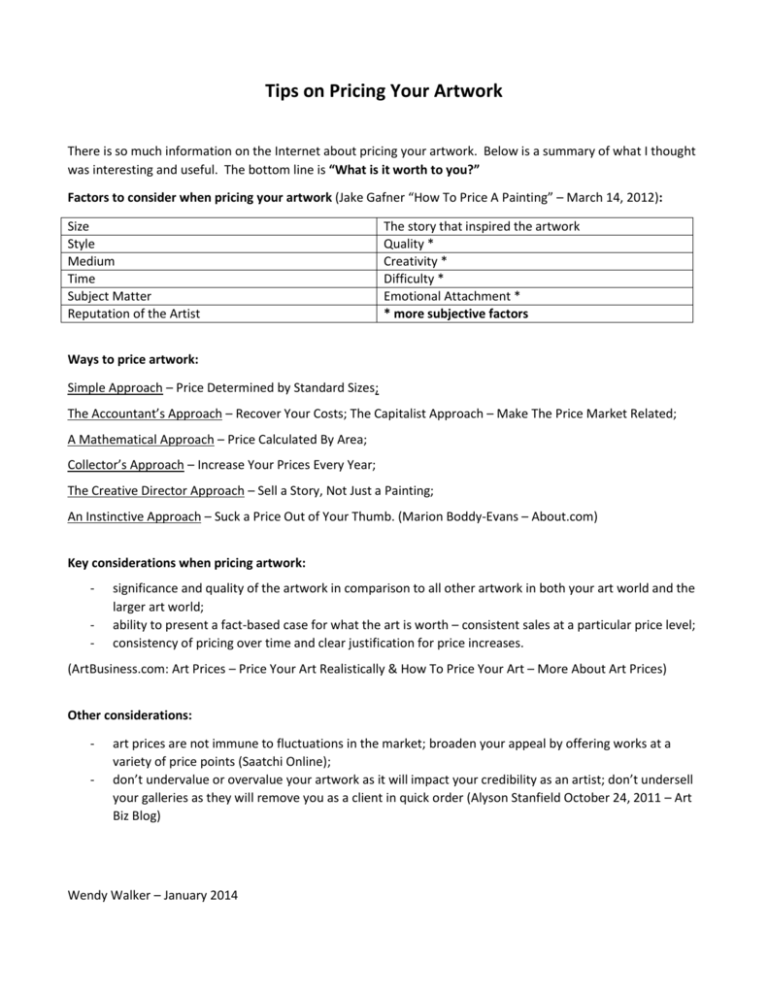
Tips on Pricing Your Artwork There is so much information on the Internet about pricing your artwork. Below is a summary of what I thought was interesting and useful. The bottom line is “What is it worth to you?” Factors to consider when pricing your artwork (Jake Gafner “How To Price A Painting” – March 14, 2012): Size Style Medium Time Subject Matter Reputation of the Artist The story that inspired the artwork Quality * Creativity * Difficulty * Emotional Attachment * * more subjective factors Ways to price artwork: Simple Approach – Price Determined by Standard Sizes; The Accountant’s Approach – Recover Your Costs; The Capitalist Approach – Make The Price Market Related; A Mathematical Approach – Price Calculated By Area; Collector’s Approach – Increase Your Prices Every Year; The Creative Director Approach – Sell a Story, Not Just a Painting; An Instinctive Approach – Suck a Price Out of Your Thumb. (Marion Boddy-Evans – About.com) Key considerations when pricing artwork: - significance and quality of the artwork in comparison to all other artwork in both your art world and the larger art world; ability to present a fact-based case for what the art is worth – consistent sales at a particular price level; consistency of pricing over time and clear justification for price increases. (ArtBusiness.com: Art Prices – Price Your Art Realistically & How To Price Your Art – More About Art Prices) Other considerations: - art prices are not immune to fluctuations in the market; broaden your appeal by offering works at a variety of price points (Saatchi Online); don’t undervalue or overvalue your artwork as it will impact your credibility as an artist; don’t undersell your galleries as they will remove you as a client in quick order (Alyson Stanfield October 24, 2011 – Art Biz Blog) Wendy Walker – January 2014 Pricing Methods: Cost of Materials 1) 2x Cost of Materials; or 2) Cost of Materials plus your hourly rate x hours spent creating the artwork Price Per Square Inch 1) Multiply the width x length of the unframed painting 2) Multiply 1) above times a set price per square inch (e.g. $0.25 to $1.50) 3) Larger paintings become quite high priced with this method. Sliding Scale Method 1) Add the width plus the length (one side each) 2) Create a chart of ranges (10” or less; 20” or less; 30” or less) 3) Set a factor for each range ( 10 or less might start at “9”; 20 or less would then be “10” and 30 or less would then be “11”) 4) Multiply 1) above times the factor that corresponds to your frame calculation (8” + 10” = 18 Factor is “10” for 20 or less so multiply 18 x 10 + $180 5) To increase your prices, increase the factor across the ranges (10 or less would become “10”; 20 or less would be “12”; 30 or less would be “13”) 6) Smaller paintings are higher priced with this method; however, larger paintings are more affordable. Linear Inch Method 1) Similar to the Sliding Scale Method except you base your factor on a range of sold paintings. 2) Take the price of one small, one medium and one large painting that you have sold and for a price that you feel comfortable with. 3) Divide the price of each painting by the width plus the length. This will give you an approximate value per linear inch for that particular size of painting $180/18” = $10 per linear inch. Market Value 4) Compare your work with other artwork of the same size, quality, composition, medium, artist’s accomplishments, etc. 5) This method is subjective so consistency of pricing would be a consideration. Wendy Walker – January 2014



